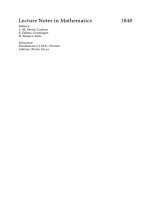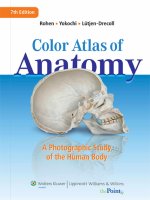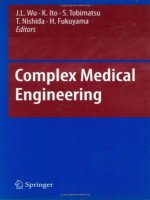complex medical engineering - j. wu, et al., (springer, 2007)
Bạn đang xem bản rút gọn của tài liệu. Xem và tải ngay bản đầy đủ của tài liệu tại đây (26.92 MB, 597 trang )
J.L. Wu, K. Ito, S. Tobimatsu, T. Nishida, H. Fukuyama (Eds.)
Complex Medical Engineering
J.L. Wu, K. Ito, S. Tobimatsu, T. Nishida,
H. Fukuyama (Eds.)
Complex Medical Engineering
With 274 Figures, Including 7 in Color
Springer
Jing Long Wu, Ph.D., Professor
Department of Intelligent Mechanical Systems, Faculty of Engineering, Kagawa
University
2217-20 Hayashi, Takamatsu 761-0396, Japan
Koji Ito, Dr.Eng., Professor
Complex Systems Analysis, Adaptive & Learning Systems, Tokyo Institute of
Technology
4259 Nagatsuta, Midori-ku, Yokohama 226-8503, Japan
Shozo Tobimatsu, M.D., Professor and Chairman
Department of Clinical Neurophysiology, Neurological Institute, Graduate School of
Medical Science, Kyushu University
3-1-1 Maidashi, Higashi-ku, Fukuoka 812-8582, Japan
Toyoaki Nishida, Dr.Eng., Professor
Department of Intelligence Science and Technology, Graduate School of Informatics
Kyoto University
Yoshida Honmachi, Sakyo-ku, Kyoto 606-8501, Japan
Hidenao Fukuyama, M.D., Ph.D., Professor
Human Brain Research Center, Kyoto University Graduate School of Medicine
54 Shogoin Kawahara-cho, Sakyo-ku, Kyoto 606-8507, Japan
ISBN-10 4-431-30961-6 Springer Tokyo Berlin Heidelberg New York
ISBN-13 978-4-431-3096M Springer Tokyo Berlin Heidelberg New York
Library of Congress Control Number: 2006930401
Printed on acid-free paper
© Springer 2007
Printed in Japan
This work is subject to copyright. All rights are reserved, whether the whole or part of the material
is concerned, specifically the rights of translation, reprinting, reuse of illustrations, recitation, broad-
casting, reproduction on microfilms or in other ways, and storage in data banks.
The use of registered names, trademarks, etc. in this publication does not imply, even in the absence
of a specific statement, that such names are exempt from the relevant protective laws and regulations
and therefore free for general use.
Product liability: The publisher can give no guarantee for information about drug dosage and applica-
tion thereof contained in this book. In every individual case the respective user must check its accuracy
by consulting other pharmaceutical literature.
Springer is a part of Springer Science+Business Media
springer.com
Typesetting: Camera-ready by the editors and authors
Printing and binding: Asia Printing, Japan
Preface
In the twenty-first century, applications in medicine and engineering must
acquire greater safety and flexibility if they are to yield better products at
higher efficiency. To this end, complex science and technology must be
integrated in medicine and engineering. Complex medical engineering
(CME) is a new field comprising complex medical science and technology.
Included are biomedical robotics and biomechatronics, complex virtual
technology in medicine, information and communication technology in
medicine, complex technology in rehabilitation, cognitive neuroscience and
technology, and complex bioinformatics.
This book is a collection of chapters from experts in academia, industry,
and government research laboratories who have pioneered the ideas and
technologies associated with CME. Containing 54 research papers that were
selected from 260 papers submitted to the First International Conference on
Complex Medical Engineering (CME2005), the book offers a thorough
introduction and a systematic overview of the new field. The papers are
organized into six parts. Part 1 focuses on biomedical robotics and biome-
chatronics and discusses principles and applications associated with the
micropump, tactile sensor, underwater robot, laser surgery, and noninvasive
monitoring. Part 2 discusses complex virtual technology in medicine, which
involves visualization, simulators, displays, robotic systems, and walking-
training systems. In Part 3, the authors provide a comprehensive discussion
of information and communication technology in medicine. In Part 4,
complex technology in rehabilitation is discussed, with topics including
rehabilitation robotics and neurorehabilitation. In Part 5, the authors discuss
cognitive neuroscience and technology in five areas: complex medical
imaging, including PET and MRI; human vision and technologies; brain
science and cognitive technologies; transcranial magnetic stimulation
(TMS);
and electroencephalogram (EEG), neuron disease, and diagnostic
technology. In Part 6, the authors discuss topics associated with complex
bioinformatics.
We first proposed the new term "complex medical engineering" for the
First International Conference on Complex Medical Engineering (CME2005),
which was successfully held in Takamatsu, Japan, in 2005 (http://frontier.
VI Preface
eng.kagawa-u.ac.jp/CME2005/). When the conference was announced, we
soon received a vast number of responses as well as support from the
research community, industry, and many organizations. To meet the strong
demands for participation and the growing interest in CME, the Institute of
Complex Medical Engineering (ICME) was founded in 2005. The ICME
is an international academic society (
ICME/), the aim of which is to bring together researchers and practitioners
from diverse fields related to complex medical science and technology.
ICME conferences are expected to stimulate future research and develop-
ment of new theories, new approaches, and new tools to expand the growing
field of CME. The First Symposium on Complex Medical Engineering
( and The Second Interna-
tional Conference on Complex Medical Engineering (.
kagawa-u.ac.jp/CME2007/) will be held in Kyoto, Japan, and Beijing, China,
respectively.
This book is recommended by the ICME as the first book on CME
research. It is a collaborative effort involving many leading researchers and
practitioners who have contributed chapters on their areas of expertise. Here,
we would like to thank all authors and reviewers for their contributions.
We are very grateful to people who joined or supported the CME-related
research activities, and in particular, to the ICME council members:
Y. Nishikawa, H. Shibasaki, H. Takeuchi, C.A. Hunt, J. Liu, J.C. Rothwell,
M. Hashizume, M. Hallett, M.C. Lee, N. Franceschini, N. Zhong, P. Wen,
R. Turner, S. Miyauchi, S. Tsumoto, W. Nowinski, Y. Deng, S. Doi, T.
Touge, T. Kochiyama, M. Tanaka and R. Lastra. We thank them for their
strong support.
Last but not least, we thank staffs at Springer Japan for their help in
coordinating this monograph and for their editorial assistance.
Jing Long Wu
Koji Ito
Shozo Tobimatsu
Toyoaki Nishida
Hidenao Fukuyama
Contents
Preface V
1.
Biomedical Robotics and Biomechatronics
Improving the Performance of a Traveling Wave Micropump for Fluid
Transport in Micro Total Analysis Systems
T SUZUKI, I. KANNO, H. HATA, H. SHINTAKU, S. KAWANO,
and H. KOTERA 3
Vision-based Tactile Sensor for Endoscopy
K. TAKASHIMA, K. YOSHINAKA, and K. IKEUCHI 13
6-DOF Manipulator-based Novel Type of Support System for
Biomedical Applications
S. Guo, Q. WANG, and G. SONG 25
The Development of a New Kind of Underwater Walking Robot
W. ZHANG, and S. Guo 35
Mid-Infrared Robotic Laser Surgery System in Neurosurgery
S. OMORI, R. NAKUMURA, Y. MURAGAKI, I. SAKUMA,
K. MIURA, M. DOI, and H. ISEKI 47
Development of a Compact Automatic Focusing System for a
Neurosurgical Laser Instrument
M. NOGUCHI, E. AOKI, E. KOBAYASHI, S. OMORI, Y. MURAGAKI,
H. ISEKi, and I. SAKUMA 57
Non-invasive Monitoring of Arterial Wall Impedance
A. SAKANE, K. SHIBA, T. TSUJI, N. SAEKI, and
M. KAWAMOTO 67
VIII Contents
2.
Complex Virtual Technology in Medicine
Advanced Volume Visualization for Interactive Extraction and
Physics-based Modeling of Volume Data
M. NAKAO, T. KURODA, and K. MINATO 81
Development of a Prosthetic Walking Training System for Lower
Extremity Amputees
T WADA, S. TANAKA, T TAKEUCHI, K. IKUTA, and
K. TSUKAMOTO 93
Electrophysiological Heart Simulator Equipped with Sketchy 3-D
Modeling
R. HARAGUCHI, T IGARASHI, S. OWADA, T YAO, T NAMBA,
T ASHIHARA, T IKEDA, and K. NAKAZAWA 107
Three-dimensional Display System of Individual Mandibular
Movement
M. KOSEKI, A. NllTSUMA, N. INOU, and K. MAKI 117
Robotic System for Less Invasive Abdominal Surgery
I. SAKUMA, T SUZUKI, E. AOKI, E. KOBAYASHI, H. YAMASHITA,
N. HATA, T DOHI, K. KONISHI, and M. HASHIZUME 129
3.
Information and Communication Technology in Medicine
Attribute Selection Measures with Possibility and Their Application
to Classifying MRSA from MSSA
K. HiRATA, M. HARAO, M. WADA, S. OZAKI, S. YOKOYAMA,
and K. MATSUOKA 143
A Virtual Schooling System for Hospitalized Children
E. HAN ADA, M. MIYAMOTO, and K. MORI YAM A 153
Using Computational Intelligence Methods in a Web-Based Drug
Safety Information Community
A.A. GHAIBEH, M. SASAKI, E.N. DOOLIN, K. SAKAMOTO,
H. CHUMAN, and A. YAMAUCHI 165
Analysis of Hospital Management Data using Generalized
Linear Model
Y TSUMOTO and S. TSUMOTO 173
Contents IX
Data Mining Approach on Clinical/Pharmaceutical Information
accumulated in the Drug Safety Information Community
A. YAMAUCHI, K. SAKAMOTO, and H. CHUMAN 187
Clinical Decision Support based on Mobile Telecommunication
Systems
S. TSUMOTO, S. HiRANO, and E. HANADA 195
Web Intelligence Meets Immunology
J. LIU, N. ZHONG, Y. YAO, and J.L. Wu 205
4.
Complex Technology in Rehabilitation
Hand Movement Compensation on Visual Target Tracking for
Patients with Movement Disorders
J. IDE, T. SUGI, M. NAKAMURA, and H. SHIBASAKI 217
Approach Motion Generation of the Self-Aided Manipulator for
Bed-ridden Patients
A. HANAFUSA, H. WASHIDA, J. SASAKI, T. FUWA, and
Y SHIOTA 227
Lower-limb Joint Torque and Position Controls by Functional
Electrical Stimulation (FES)
K. ITO, T. SHIOYAMA, and T. KONDO 239
Pattern Recognition of EEG Signals During Right and Left Motor
Imagery ^ Learning Effects of the Subjects ~
K. INOUE, D. MORI, G. PFURTSCHELLER, and K. KUMAMARU 251
A Hierarchical Interaction in Musical Ensemble
Performance: Analysis of 1-bar Rhythm and Respiration
Rhythm
T. YAMAMOTO and Y MIYAKE 263
Comparison of the Reaction Time Measurement System for
Evaluating Robot Assisted Activities
T. HASHIMOTO, K. SUGAYA, T. HAMADA, T. AKAZAWA,
Y KAGAWA, Y TAKAKURA, Y TAKAHASHI, S. KUSANO,
M. NAGANUMA, and R. KiMURA 275
X Contents
5. Cognitive Neuroscience and Technology
Influence of Interhemispheric Interactions on Paretic Hand
Movement in Chronic Subcortical Stroke
N.
MURASE, J. DUQUE, R. MAZZOCCHIO, and L.G. COHEN 289
BOLD Contrast fMRI as a Tool for Imaging Neuroscience
R. TURNER 297
What can be Observed from Functional Neuroimaging?
J. RiERA 313
Human Brain Atlases in Education, Research and Clinical
Applications
W.L. NOWINSKI 335
Deploying Chinese Visible Human Data on Anatomical
Exploration: From Western Medicine to Chinese
Acupuncture
RA. HENG, S.X. ZHANG, Y.M. XIE, TJ. WONG, Y.R CHUI,
and J.C.Y. CHENG 351
MEG Single-event Analysis: Networks for Normal Brain Function
and Their Changes in Schizophrenia
A.A. lOANNIDES 361
MEG and Complex Systems
G.R. BARNES, M.I.G. SIMPSON, A. HILLEBRAND, A. HADJIPAPAS,
C. WiTTON, and RL. FURLONG 375
MEG Source Localization under Multiple Constraints:
An Extended Bayesian Framework
J. MATTOUT, C. PHILLIPS, R. HENSON, and K. FRISTON 383
Differential Contribution of Early Visual Areas to Perception of
Contextual Effects: fMRI Studies
Y. EJIMA 397
Brain-machine Interface to Detect Real Dynamics of Neuronal
Assemblies in the Working Brain
Y. SAKURAI 407
Contents XI
Prism-adaptation Therapy for Unilateral Neglect: from the
Facts to a Bottom-up Explanatory Model
R. PATRICE, P. LAURE, L. JACQUES, J C. SOPHIE, R ALESSANDRO,
O. HiSAAKi, R. GiLLES, B. DOMINIQUE, and R. YVES 413
Somatosensory Processing in the Postcentral, Intraparietal and
Parietal Opercular Cortical Regions
Y. IWAMURA 423
Predicting Motor Intention
M. HALLETT and O. BAI 439
Cortical Field Potentials and Cognitive Functions
H. GEMBA 447
FMRI Studies on Passively Listening to Words, Nonsense Words,
and Separated KANAs of Japanese
C. CAI, T. KOCHIYAMA, T. SATAKE, K. OSAKA, and J.L. Wu 459
Interpretation of Increases in Deoxy-Hb during Functional
Activation
Y HOSHI, S. KOHRI, and N. KOBAYASHI 469
Probing the Plasticity of the Brain with TMS
J.C. ROTHWELL 481
Time Series of Awake Background EEG Generated by a Model
Reflecting the EEG Report
S. NiSHiDA, M. NAKAMURA, A. IKEDA, T. NAGAMINE,
and H. SHIBASAKI 489
Event-related Changes in the Spontaneous Brain Activity during 3D
Perception from Random-dot Motion
S. IWAKI, G. BONMASSAR, and J.W. BELLIVEAU 499
Effects of Electric or Magnetic Brain Stimulation on Cortical and
Subcortical Neural Functions in Rats
T. TOUGE, D. GONZALEZ, T. MIKI, C. HIRAMINE,
and H. TAKEUCHI 511
XII Contents
Event-related Potentials and Stimulus Repetition in Explicit and
Implicit Memory Tasks
H. TACHIBANA 517
Multichannel Surface EMGs to Assess Function of Spinal Anterior
Horn Cells
K. OGATA, T. KUROKAWA-KURODA, Y. GOTO, and
S. TOBIMATSU 527
Cortical Processing of Sound in Patients with Sensorineural Hearing
Loss
Y. NAITO 535
Efficacy of the Levodopa on Frontal Lobe Dysfunction in Patients
with de Novo Parkinson's Disease; A Study Using the
Event-related Potential
K. HiRATA, Y WATANABE, A. HozuMi, H. TANAKA, M. ARAI,
Y KAJI, M. SAITO, and K. IWATA 545
6. Complex Bioinformatics
A Wireless Integrated Immunosensor
T. ISHIKAWA, T S. AYTUR, and B.E. BOSER 555
Dynamics of Cortical Neurons and Spike Timing Variability
T. TATENO 565
Can Newtonian Mechanics Aid in the Development of Brain
Science?: A Challenge to Bernstein's Degrees-of-Freedom Problem
S. ARIMOTO and M. SEKIMOTO 573
Novel Registration Method for DSA Images Based on Thin-plate
Spline
J. YANG, S. TANG, Q. LI, Y LIU, and Y WANG 595
Development of a Simulator of Cardiac Function Estimation for
before and after Left Ventricular Plasty Surgery
T. TOKUYASU, A. ICHIYA, T. KiTAMURA, G. SAKAGUCHI,
and M. KOMEDA 605
Key Word Index 617
Part
1
Biomedical Robotics
and
Biomechatronics
Improving the Performance of a Traveling Wave
Micropump for Fluid Transport in Micro Total
Analysis Systems
Takaaki Suzuki', Isaku Kanno', Hidetoshi Hata', Hirofumi Shintaku^
Satoyuki Kawano^, and Hidetoshi Kotera'
' Department of Microengineering, Kyoto University
^
Department of Mechanical Science and Bioengineering, Osaka Univer-
sity
Chapter Overview. Micropumps are one of the most important microflu-
idic components in Micro Total Analysis System (}iTAS). The authors
have developed a traveling wave micropump that demonstrates high en-
ergy efficiency and does not require valves. A prototype valveless micro-
pump was fabricated using microfabrication techniques to validate the
pumping principle. The micropump uses piezoelectric bimorph cantilevers
to deform a flexible microchannel wall. Traveling waves are induced on
the surface of the microchannel by applying properly phased sinusoidal
voltage to the piezoelectric cantilevers. The resulting peristaltic motion of
the channel wall transports the fluid. The fluid flow in the micropump was
numerically simulated with the computational fluid dynamics code,
FLUENT. Comparing the experimental and numerical results confirmed
that the proposed modeling method can accurately evaluate the perform-
ances of the traveling wave micropump. Based on the flow obtained in
numerical analysis, an improvement in the pump efficiency is expected
with optimization of the shape of the moving wall.
Key Words. Micropump, and Fluid Transport
4 T. Suzuki et al.
1.
Introduction
In recent years, the field of Micro Total Analysis Systems (}j,TAS) has be-
come a highly active. The main advantages of |iTASs compared to con-
ventional macro-scale analysis systems are reduced sample and reagent
volumes, high throughput screening capability (parallel analyses), lower
cost, and portability.
A key component in jiTASs is the micropump. A variety of micropumps
have been proposed for fluid transportation and manipulation systems, but
conventional diaphragm-type micropumps that use mechanical valves or
diffuser / nozzle elements have a complicated structure and high fluidic
impedance [1, 2]. To address these limitations, the authors have proposed
and developed a novel valveless traveling wave micropump [3]. It uses
piezoelectric bimorph beams to induce a traveling wave in a flexible mi-
crochannel made of silicon rubber. Despite the advantages of the micro-
pump, its performance needs improvement to fully realize its potential for
micro biological and chemical analysis in medical diagnosis.
In this paper, the performance of the valveless traveling wave micro-
pump is improved by using PZT beams that generate larger deflection. In
addition, the fluid flow in the micropump is numerically simulated to in-
vestigate the relationship between the fluid transportation characteristics,
the deflection of the actuators, and the shape of the microchannel in the
micropump. Based on these relationships, the performance of the traveling
wave micropump is improved by optimizing the internal structure of the
flexible microchannel.
2.
Principle of Fluid Transportation
The traveling wave micropump is composed of the two components as
shown in Fig. 1, i.e. a microchannel and an actuator array. The piezoelec-
tric actuator array uses PZT beams to generate traveling waves on a flexi-
ble wall of the microchannel. The fluid flow was controlled by changing
the sine wave forms of the applied voltage. By changing the phases of the
voltage that is applied to the PZT beams, the micropump can induce bi-
directional fluid flow without using mechanical valves.
The trajectory of
a
fluid particle near the moving wall of
the
microchan-
nel follows an elliptic path. After a period of wave oscillation, a fluid par-
ticle travels along the channel a small amount from the initial position. The
net fluid transport is achieved by repeating such motion in the viscous
fluid. The proposed micropump can transport micro samples in carrier
Improving the Performance of
a
Traveling Wave Micropump
for Fluid Transport in Micro Total Analysis Systems
without collapsing sample surface, because the amplitude of the traveling
wave on the microchannel wall is about 1/50 of the height of the micro-
channel and the micropump does not have mechanical valves.
Yin and Fung [4] theoretical analyzed the two-dimensional peristaltic
pump velocity profile using the perturbation method. Following this analy-
sis method, consider that the following traveling wave is applied to the
fluid
In / \
rj
=
acos—[x - ct).
(1)
where a is the amplitude of the traveling wave, A the wavelength of the
traveling wave, and c the velocity of the traveling wave. The time-
averaged flow velocity of the x-direction
w
is
1
a'^iz).
(2)
where W (z) is a function of the height of the microchannel. From Eq.(2),
one can conclude that time-averaged flow velocity in the x-direction is
proportional to the square of the amplitude of the microchannel traveling
wave.
Traveling
wave
Fig. 1. Principle of
fluid
transport in a traveling wave micropump driven by pie-
zoelectric actuators.
6 T. Suzuki et al.
3. Experimental Development
3.1 Fabrication process
A valveless micropump driven by PZT beams was fabricated using soft-
lithography [5]. The microchannel of the traveUng wave micropump con-
sists of two layers: a groove layer that constitutes the bottom and side
walls of the microchannel, and a thin cover layer that has bumps. Each
layer was fabricated by casting PDMS (Polydimethylsiloxane) onto master
molds. Thick SU-8 photoresist was used to fabricate the master molds.
The fabrication process is shown in Fig. 2. The SU-8 was first spin
coated with a thickness of lOOjim on a glass substrate. The microchannel
was fabricated on a glass substrate using photolithography. PDMS was
poured on the master and degassed using vacuum-forming to mold the mi-
crochannel. Finally, the PDMS sheet was peeled off the master and bonded
to the PDMS sheet with bumps. The cross-section of the microchannel was
200fim wide and 100|im high.
L
(a) Spin coating SU-8 with the thickness
of 10Oj^m on glass substrate
(b) A master for microchannel was fabricated on a glass
substrate using photolithography procedure
(c) PDMS was poured on the master and form
the microchannel using the vacuum-forming technique
JIL
(d) Bonding with another PDMS sheet having bumps
Fig. 2. Fabrication process for the flexible microchannel using soft-lithography.
Improving the Performance of
a
Traveling Wave Micropump
for Fluid Transport in Micro Total Analysis Systems 7
3.2 Experimental observation of fluid flow generated by the
traveling wave micropump
A picture of a prototype traveling wave micropump is shown in
Fig.3.
The
top wall of the microchannel that is made from flexible material is de-
formed by the force generated by the PZT beams. Traveling waves were
induced on the surface of the microchannel by applying sinusoidal signals
with
27i/3
phase differences to each PZT beam.
The 10mm long and 1.4mm wide PZT beams were subject to a 5V sinu-
soidal voltage and their resulting tip deflection was measured using a laser
Doppler vibrometer. The tip deflection frequency response of the PZT
beams is shown in Fig.4. The deflection of the current PZT beams is larger
than that of the previously reported actuators [3]. From Eq. (2), the flow
rate is expected to be proportional to the square of the amplitude of the
traveling wave. Therefore, the current micropump is expected to have a
significantly higher performance than the previous one.
For the flow rate measurement, Ijim in diameter fluorescent microbeads
were added to the fluid. Using a fluorescent microscope, the movement of
microbeads in accord with the applied traveling wave was confirmed.
Based on initial flow observations, it was predicted that the continuous
flow rate could be improved by optimization of the applied voltage and the
system design.
Outlet
|Omifi
Fig.
3.
Photograph of the prototype micropump.
8 T. Suzuki et al.
,^-v,
s
^
4-»
a
a>
s
(U
o
jd
'H.
C/3
5
3
2
1
1
Previous actuator
Present actuator
1 ' \ ' 1 '
1
I
'** / \
1 \ j^ \
/\.^^ \
1000 2000 3000 4000
Frequency (Hz)
Fig. 4. Tip deflection frequency response of
the
current and previous PZT beams
for a 5Vpp amplitude.
4. Numerical Analysis
The fluid flow in the micropump was numerically calculated using the
computational fluid dynamics code, FLUENT. The simulations used a fi-
nite volume method for representing and evaluating the partial differential
equations that described the fluid and its movement, e.g. the governing in-
tegral equations for the conservation of
mass
and momentum.
The laminar flow in the microchannel filled with the ethanol was simu-
lated. The dimensions of the analytical model, as shown in Fig. 5, are
18000|imx200|imxl00|a,m; which is similar in size to the prototype micro-
channel. There are 585546 tetrahedral cells in the initial analytical model.
In order to describe the wall motion induced by the PZT beams, a dynamic
mesh was used, whereby the shape of the domain changes with time due to
the domain boundary motion. The update of the volume mesh is handled at
each time step based on the new positions of the boundaries. When the
properly phased sinusoidal voltages are applied to the array of PZT beams,
the resulting traveling wave on the microchannel wall has an amplitude of
2.5|im, a period of
1.0msec,
and a wavelength of 6000|im. The inlet and
outlet were assumed to have zero backpressure.
The numerical time-averaged fluid flow in the microchannel is shown in
Fig.6.
The velocity profile in the microchannel is not symmetric because
the flow near the moving wall is faster than the velocity near the lower
Improving the Performance of
a
Traveling Wave Micropump
for Fluid Transport in Micro Total Analysis Systems 9
rigid wall. This unique fluid flow is suitable for cell separation applica-
tions.
The numerically computed and experimentally measured flow rates as a
function of frequency are shown in Fig.7. Because the numerical results
follow a similar trend to that observed in experiments, the proposed ana-
lytical procedure can be used to accurately model the fluid flow in the
traveling wave micropump. Therefore, proposed modeling techniques can
be used to optimize the structure of the microchannel to increase the en-
ergy efficiency of traveling wave-type micropumps.
Pressure outlet
Back Pre&sure: OPa
Traveling wave
IOOQIH
Pressure inlet
Back Pressure UPa
20Dpm
Fig. 5. Analytical model for micropump driven by traveling waves.
Traveling wave
100
80
60
40
20
0
A^
Movingwall
Vmax=7.75x10m/s
\/mean=3.12X 10 m/S
Rigid wall
Fig. 6. Numerically computed time-averaged velocity profile.
10
T.
Suzuki
et al.
0.05
Numerical result
Experimental result
•
' ' I
1000
1500
2000
Frequency
(Hz)
Fig.
7.
Experimental
and
numerical flow rate
as a
function
of
frequency.
5. Geometry Optimization
of
tlie IVIicrochannel
Based
on the
fluid flow obtained
in the
numerical analysis,
it
appears that
the efficiency
of
the traveling wave micropump
can be
improved
by
modi-
fying
the
surface
of
the moving wall
as
shown
in
Figs.
8 (b) and (c). For a
microchannel excitation with
a 1.4f,im
amplitude,
1.3kHz
frequency,
and
6000|im wavelength,
the
numerical flow rates
for the
wall designs
(a), (b),
and
(c) are
0.040}il/s, 0.0510}il/s,
and
0.0542}il/s, respectively. These
re-
sults indicated that
the
flow rate
of the
micropump
can be
increased
by
34%
using
the (c)
design instead
of
the original
(a)
design.
The relationship between
the
"teeth" height
and the
time-averaged flow
rate
is
shown
in Fig. 9,
where
h is the
teeth height,
//the
height
of the mi-
crochannel,
^0 the
flow rate
of
the micropump
(a), and
Qh
the
flow rate
of
the micropump with
the
"teeth"
of
height
/z,
respectively.
The
shape
of the
microchannel
is
shown
in Fig. 8 (b). The
time-averaged flow rate
is ap-
proximately proportional
to the
square
of the
"teeth" height.
A
significant
improvement
in
pumping performance
is
expected
by
optimizing
the mi-
crochannel structure using
the
proposed analytical procedure.
Improving the Performance of
a
Traveling Wave Micropump
for Fluid Transport in Micro Total Analysis Systems 11
I 90|Lini ! \^^m
Fig. 8. Geometric optimization of traveling wave micropump.
h/H
Fig. 9. Relationship between "teeth" height and the time-averaged flow rate.
12 T. Suzuki et al.
6. Conclusion
In this paper, a prototype micropump driven by traveling waves was fabri-
cated, experimentally characterized, and numerically modeled to improve
the flow rate of the micropump. The higher flow rate of the current micro-
pump compared to the previous one was achieved by using higher deflec-
tion PZT beams. Based on comparison of the experimental and numerical
results, the proposed numerical modeling procedure was validated for
simulating the pump performance. In order to improve the efficiency of the
micropump, geometry optimization of the flexible microchannel wall was
carried out. The flow rate was predicted to be proportional to the height of
the "teeth" on the moving wall.
Acknowledgment
This study is a part of Kyoto City Collaboration of Regional Entities for
the Advancement of Technological Excellence of JST on the basis of re-
search results supported in part by grant-in-aids for Scientific Researches
(A) (No. 14205037 and No. 15201033) and Center of Excellence for Re-
search and Education on Complex Functional Mechanical Systems (COE
program) of MEXT, Japan. The authors would like to thank Jacob J.
Loverich in Kyoto University for helpful discussions.
References
1.
Linnemann R, Woias P, Senfft CD, Ditterich JA (1998) A self-priming and
bubble-tolerant piezoelectric silicon micropump for liquids and gases. Proc.
IEEE MEMS 1998:532-537
2.
Cabuz C, Herb WR, Cabuz EI, Lu ST (2001) The dual diaphragm pump. Proc.
IEEE MEMS 2001:519-522
3.
Kanno I, Kawano S, Yakushiji S, Kotera H (2003) Characterization of piezo-
electric micropump driven by traveling waves. Proc. fiTAS 2003:997-1000
4.
Yin FCP, Fung YC (1971) Comparison of theory and experiment in peristaltic
transport. J. Fluid Mechanics 47:93-112
5.
Sia SK, Whitesides CM (2003) Microfluidic devices fabricated in poly) di-
methylsiloxane) for biological studies. Electrophoresis 24:3563-3576
Vision-based Tactile Sensor for Endoscopy
Kazuto Takashima\ Kiyoshi Yoshinaka", and Ken Ikeuchi^
^Institute for Frontier Medical Sciences, Kyoto University
"National Institute of Advanced Industrial Science and Technology
Chapter Overview. Endoscopy would become more useful if the visual
information obtained with it could be combined with tactile information.
We therefore developed a new tactile sensor system with this feature using
image processing of an infrared cut pattern. It is possible to install this sen-
sor on the tip of an endoscope easily because wires for power delivery and
transmission of signals are unnecessary. Doctors can use this sensor for
visual diagnosis because it does not degrade diagnostic images. In this
study, changes were made in the sensor to improve the accuracy of meas-
urement and detect stiffness of living tissue. First, we corrected sensor
output by considering sensor deformation characteristics, and were thus
able to evaluate state of contact in inserting the endoscope into a vessel
model. Second, we modified the sensor to detect not only three-axis force
but also compressive modulus. The difference in compressive moduli be-
tween several industrial materials is discernible by measurement with the
prototype of this sensor.
Key Words. Tactile Sensor, Endoscopy.
1.
Introduction
Endoscopes are used for various medical treatments and are essential for
low invasive surgery. However, it is very difficult to manipulate endo-
scopes, because the cavities in which endoscopes navigate are narrow and
complex. In addition, the surgeon's sensory (visual and tactile) perception
14 K. Takashima et al.
is severely reduced during manipulation in low invasive surgery, because
these tools are long and flexible and have few degrees of freedom.
One method to improve manipulation of the endoscope is measurement
of tactile force between the endoscope and the caliber wall, since surgery
is essentially a visual and tactile experience [1]. However, no practical tac-
tile sensor has been developed for intravascular treatment due to the small
diameter of vessel. For example, the wires set in existing endoscopes to
deliver power and transmit signals require additional endoscope volume.
In addition, since correlation of information requires one coordinate per
sensor, more space is needed to obtain more information.
A tactile sensor is also useful for detecting the stiffness of tissues, which
can change due to disease. For example, softening of degenerated cartilage
can be estimated in vivo by palpation of the articular surface with a blunt
probe during arthroscopy. However, palpation is subjective and a low in-
vasive method to measure quantitatively stiffness is desirable.
We therefore developed a new tactile sensor system that measures tac-
tile force by image processing [2]. This sensor can detect three-axis force
and stiffness. In this study, we tested the fundamental performance of two
prototypes for two kinds of applications. We first manufactured one proto-
type to improve manipulation of intravascular endoscopes. We then manu-
factured another for arthroscopes to test sensing of living tissue in situ.
2.
Measurements
2.1.
Concept of tactile sensor
The tactile sensor shown in Fig. 1 is composed of a transparent window
including infrared (IR) cut pattern, an elastic body, and an attachment be-
tween the sensor and endoscope. The transparent window is placed in the
xy-plane, and the z-axis is aligned with the axis of the endoscope when no
load is applied on the sensor tip. Using the relations between tactile force
and displacement of the tip of the sensor, force along the z-axis (F^) is ex-
pressed as a function of area of the IR cut pattern (5), and the forces along
the X-axis and y-axis
(F^c
and
Fy,
respectively) are expressed as functions of
displacement of the transparent window
(jc/,
y,).
If deformation characteris-
tics of the elastic body are linear, these relations are expressed as:
Fy
=
kyyi, (2)









